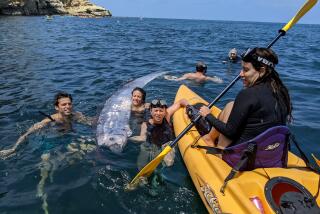Outdoor Notes : San Diego Boats Doing Well on 10-Day Trips
- Share via
The various species of tuna that have been providing anglers on overnight boats some rare fall big-game fishing off San Diego have apparently disappeared, but boats making 10-day trips to the south are finding excellent fishing, according to Carol Stock of Fisherman’s Landing in San Diego.
The Qualifier 105 had one of its most successful outings recently, 34 anglers returning to port Nov. 14 with 680 yellowfin tuna, 428 yellowtail, 211 dorado, 28 grouper and 4 wahoo. Jon Watanabe of Los Angeles hit the jackpot with a 58 1/2-pound yellowfin. Most of the tuna were in the 30- to 50-pound range with the yellowtail a bit smaller, according to Stock.
A 10-day outing by the Royal Polaris was equally rewarding, 31 anglers bringing back 602 yellowfin tuna, 536 yellowtail, 4 wahoo, 18 dorado, 2 black sea bass and 1 white sea bass. On that trip, the biggest fish was a 60 1/2-pound yellowfin tuna caught by Edgar Cook of La Mesa.
Lakewood resident Daniel Gus Noether, a U.S. Fish and Wildlife Service inspector, was among five people indicted on charges of illegally importing more than 50,000 exotic lizards, snakes and turtles into the United States from Colombia.
The federal indictment issued Wednesday charges the five with conspiring to bring $400,000 worth of live iguanas, boa constrictors, caimans, mud turtles and tegu lizards into the United States between March and September, 1986.
The animals, all protected species, were either sold as pets or re-exported to the Far East for use in fashion merchandise.
Assistant U.S. Attorney Maurice Leiter said that Noether’s indictment is the “first corruption case brought against any of the nation’s approximately 60 fish and wildlife inspectors.”
The 29-count indictment also names three Los Angeles-area animal dealers: Axel Joachim Roscher, 42; Christine Paula Roscher, 35, and Steven Michael Lundblad, 37.
Noether, 38, employed for six years as a wildlife official, was arrested at his home Wednesday. The dealers were expected to surrender voluntarily, Leiter said.
The elk population in Arizona is at an all time high, about 20,000.
Arizona Wildlife News, however points out a growing problem. As the human population increases, so does the demand for natural products, principally those made from wood. Timber is a prime source of elks’ cover.
The primary elk range in Arizona occupies a narrow band extending from the Williams area, in the northwestern part of the state, southeast along the Mogollon Rim and its associated mountains.
Growing commercial interests in these forests include the harvesting of timber and pulpwood, and clearing for livestock grazing. The way industry harvests Arizona’s timber will have a great impact on elk and other wildlife.
Increased recreational activity in Arizona’s forests means more roads and greater hunter access, which further taxes the elk herds.
The article concludes that if the elk population is to continue to prosper, public agencies that govern land and resource use in Arizona’s elk range need to take steps to assure its continued success.
Briefly The six international hunters nominated for the prestigious Weatherby Big Game Trophy--created in 1956 to honor an outstanding conservationist as well as big game hunter--are Dr. James Conklin, Pittsburgh, Pa.; Robert Chisolm, Wichita, Kan.; Robert W. Kubik, Anchorage, Alaska; Andrew A. Samuels Jr., Youngstown, Ohio; James L. Brockie, Dallas, Tex., and Bruno Scherrer, Los Angeles. The top award of the hunting world will be presented by actor Jameson Parker at a black-tie dinner Dec. 3 at the Beverly Hilton Hotel. . . . The California Waterfowl Assn. has received a $200,000 grant from the National Fish and Wildlife Foundation, which will be spent on the California Wetlands Project--a 3-year program aimed at examining mallard populations and wintering waterfowl habitat management in California.
More to Read
Sign up for The Wild
We’ll help you find the best places to hike, bike and run, as well as the perfect silent spots for meditation and yoga.
You may occasionally receive promotional content from the Los Angeles Times.






